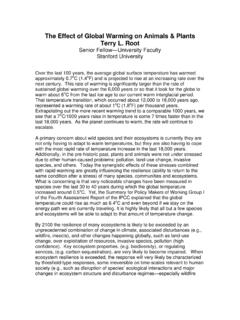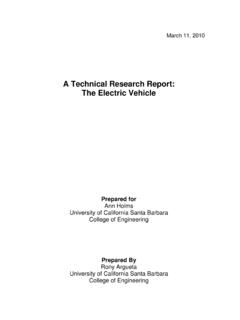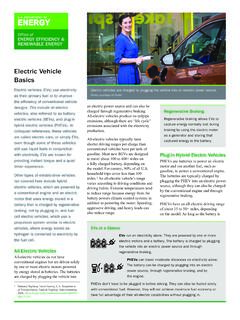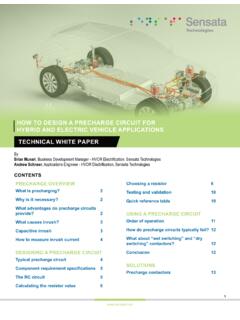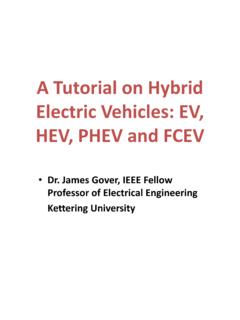Transcription of HYBRID BUSES COSTS AND BENEFITS
1 HYBRID BUSES . COSTS AND BENEFITS . Key Facts In 2005, more than 60 percent of the billion transit passenger trips in the United States were provided by BUSES , approximately 84 percent of which are powered by diesel combustion Diesel exhaust contains ozone precursors, benzene, arsenic, dioxins, formaldehyde and other toxic substances and is a significant contributor to airborne concentrations of fine particulate matter (PM). Significant health impacts including lung damage and premature death are associated with exposure to fine particulate matter.
2 It can also aggravate conditions such as asthma and bronchitis. Diesel exhaust has also been classified as a probable human carcinogen with no known safe level of exposure. 2. In response to air quality and health concerns as well as rising fuel COSTS , a growing number of transit agencies are turning to HYBRID - electric BUSES , which consume less energy and produce significantly fewer emissions by combining an internal combustion engine with an electric motor. Technology Overview A HYBRID - electric bus is powered by an electric motor, and a smaller than normal conventional internal combustion engine.
3 To achieve heightened efficiency, the battery powered electric motor allows the combustion engine to operate at periods of maximum efficiency. The major components of a HYBRID drive system include an internal combustion engine (ICE), a generator, a battery pack, and an electric motor. The most commonly used batteries in HYBRID vehicles are lead-acid or nickel-metal hydride. Ultra low sulfur diesel is the most common fuel used to power the combustion engine in hybrids, although other fuels such as gasoline, compressed natural gas (CNG), liquid natural gas (LNG), biodiesel, and hydrogen have also been used.
4 A majority of the HYBRID BUSES in service are 40-foot BUSES . However, 22-foot shuttle BUSES and 60-foot articulated BUSES have also been deployed. The three major manufacturers of HYBRID systems are GM-Allison Transmission, BAE. Systems, and ISE Corporation. Ebus produces 22-foot shuttle BUSES . There are two different types of HYBRID systems - parallel and series hybrids. 1. American Public Transportation Association, Public Transportation Ridership Statistics, Fourth Quarter2005. 2. US Environmental Protection Agency, Diesel Exhaust and Your Health , 1.
5 In a parallel HYBRID bus, the Parallel HYBRID electric Configuration combustion engine and the electric motor are connected to the transmission independently. The electric motor is designed to provide power during stop-and-go traffic while at highway speeds the vehicle is powered solely by the internal Source: Southwest Research Institute combustion engine. During acceleration, both the electric motor and the combustion engine power the transmission. In addition, through a process called regenerative breaking, energy lost due to braking is recovered and utilized to charge the battery.
6 A series HYBRID bus is exclusively propelled by the electric motor. In a Series HYBRID electric Configuration series HYBRID bus, the internal combustion engine (ICE) is connected to an electric generator which converts the energy produced by the ICE into electric power . This electricity powers a motor which turns the wheels of the vehicle. The Source: Southwest Research Institute generator also recharges a battery pack which provides supplemental power to the motor. Since the ICE is not connected to the wheels, it can operate at an optimum rate and can even be switched off for short periods of time for a temporary all- electric operation of the bus.
7 Parallel hybrids have greater fuel efficiency than series hybrids at constant high speeds (highway driving) while the series hybrids fare better in stop-and-go urban driving. BENEFITS of HYBRID BUSES HYBRID BUSES offer a wide range of BENEFITS including significantly lower emissions, increased efficiency, and decreased maintenance COSTS . Reduced Emissions HYBRID BUSES are estimated to cut emissions by as much as 75 percent when compared to conventional diesel BUSES . The emissions reductions are a function of the electric drive, ultra low-sulfur diesel (ULSD) fuel use in conjunction with particulate trap technology and improved fuel economy from the HYBRID system.
8 In-use testing and industry reports indicate that particulate matter (PM) emissions from HYBRID BUSES equipped with particulate matter filters are almost 90 percent lower than a conventional diesel bus without a particulate filter. According to a study conducted by the Northeast Advanced Vehicle Coalition (NAVC) to demonstrate energy efficiency and emissions performance of diesel- electric HYBRID BUSES , nitrogen oxides (NOx) emissions for diesel hybrids were 30 to 40 percent lower than conventional diesel vehicles.
9 2. Diesel HYBRID BUSES exhibited the lowest carbon monoxide (CO) emissions of any of the BUSES tested including CNG and conventional diesel. Hybrids demonstrated lower greenhouse gas emissions than those of a conventional diesel bus or CNG powered bus as a result of improved fuel economy. 3. A separate evaluation by New York City Transit (NYCT) reports significant emissions reductions for the Orion VII BUSES equipped with BAE Systems' series HYBRID drive. In the chart below, emissions from the HYBRID bus are compared with the emissions from a conventional diesel bus equipped with a diesel particulate filter and a comparable CNG NYCT Conventional Diesel vs HYBRID Bus Emissions 3 grams/mile * NMHC for CNG.
10 0. PM*10 NOx/10 CO/5 THC*. Standard Diesel CNG Orion VI HYBRID Orion VII HYBRID (with DPF)* (with DPF)* (with DPF)*. *ULSD Fuel was used in all diesel and hybrids Performance HYBRID BUSES typically exhibit performance levels comparable to their non- HYBRID counterparts. Transit agencies report that acceleration in HYBRID - electric BUSES is smoother and faster due to the increased low-end torque characteristics of electric Quieter Operation: Although there has been little systematic testing of HYBRID BUSES for noise emissions, anecdotal evidence from bus drivers and passengers suggests that HYBRID BUSES offer a quieter ride when compared to conventional diesel BUSES .

